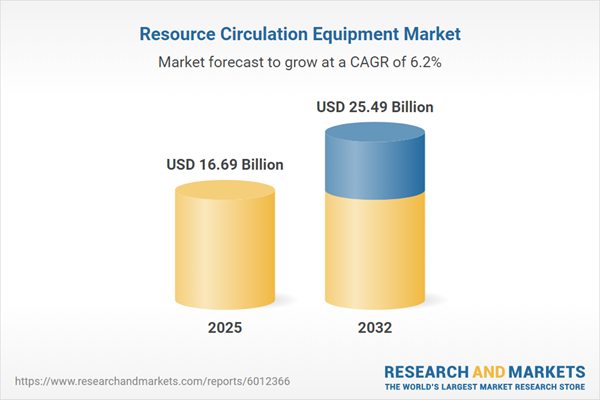Speak directly to the analyst to clarify any post sales queries you may have.
The resource circulation equipment market is experiencing significant transformation, fueled by digitization, automation, and evolving supply chain strategies. Senior decision-makers seeking operational efficiency and resilience will find actionable intelligence and strategic direction in this comprehensive report.
Market Snapshot: Resource Circulation Equipment Market Growth and Outlook
The Resource Circulation Equipment Market grew from USD 15.71 billion in 2024 to USD 16.69 billion in 2025. Forecasts indicate sustained expansion at a CAGR of 6.23%, targeting a valuation of USD 25.49 billion by 2032. Demand is shaped by ongoing investment in digital infrastructure, modernization of manufacturing facilities, and heightened supply chain complexity across key regions.
Scope & Segmentation of the Resource Circulation Equipment Market
This report provides an in-depth evaluation of the market’s structure and specialized solutions, highlighting essential segments and technologies driving adoption across industries and geographies.
- Product Types: Automated guided vehicles (laser or magnetic), conveyors (belt, roller, screw), cranes (gantry, jib, overhead), lifts (boom, hydraulic, scissor), and robotic arms (articulated, Cartesian, SCARA).
- Applications: Material handling, packaging (primary and secondary), sorting (item and parcel), and storage solutions including automated retrieval modules and pallet racking systems.
- End Users: Logistics (courier and third-party providers), manufacturing (automotive, electronics, food and beverage), retail (e-commerce, supermarket and grocery), and warehousing (cold storage, general warehouses).
- Automation Levels: Fully automated (lights out operation and supervisory control), manual (hand trolleys, pallet jacks), and semi-automated (pick to light, voice directed systems).
- Technologies: IoT-enabled (cloud and edge), laser guidance (2D and 3D), RFID (active and passive), vision guidance (2D and 3D imaging).
- Distribution Channels: Direct sales (OEM contracts, system integrators), distributors (national and regional), and online platforms (e-commerce, manufacturer websites).
- Regions: Americas (North and Latin America), Europe, Middle East & Africa (including Western and Eastern Europe, Middle East, Africa), Asia-Pacific (China, India, Japan, Southeast Asia, Australia, South Korea, Taiwan).
Key Takeaways for Strategic Decision-Makers
- The rapid integration of digital technologies such as cloud connectivity, artificial intelligence, and advanced robotics is redefining operational benchmarks and system interoperability standards.
- Flexible, modular system architectures are rising in prominence, allowing organizations to future-proof their investment and reduce time-to-value when adapting to demand fluctuations or supply chain disruptions.
- Performance-based contracts and as-a-service delivery models now enable both large enterprises and smaller organizations to scale solutions without incurring significant upfront costs or complex procurement cycles.
- Innovation alliances and joint development ventures are fostering knowledge-sharing and accelerated product advancements, benefiting firms focused on complex, multi-facility network optimization.
- Workforce training and upskilling have become essential as the shift toward automation and intelligent maintenance platforms intensifies, helping drive productivity improvements and facilitate faster technology adoption.
Tariff Impact: Navigating Regulatory and Trade Developments
The implementation of new United States tariffs in 2025 has affected global sourcing and procurement strategies for resource circulation equipment. Heightened import duties have accelerated the trend toward nearshoring and regional assembly, while prompting companies to adopt dual-sourcing strategies and explore modular, open-architecture solutions to mitigate trade-related risks. Industry consortia and technology alliances are also sharing best practices for tariff mitigation and supply chain agility.
Methodology & Data Sources
This research synthesizes insights from primary interviews with industry executives, operations managers, and technical specialists across manufacturing, logistics, retail, and warehousing backgrounds. Extensive review of industry publications, regulatory filings, patent databases, and trade reports supports robust data triangulation and validation, ensuring accuracy and relevance in the market analysis.
Why This Resource Circulation Equipment Market Report Matters
- Empowers leaders to align technology investments with evolving market and regulatory pressures, driving operational resilience and efficiency.
- Offers comparative insights into regional drivers, segment-specific adoption trends, and competitive strategies for optimal market entry and positioning.
- Equips teams with actionable intelligence on innovation partnerships and modular design pathways, facilitating smarter, scalable implementations.
Conclusion
This report delivers a clear, data-driven roadmap for senior executives to navigate evolving digital, regulatory, and operational landscapes. With its focus on actionable market segmentation and strategic adaptation, it supports confident investment in resource circulation equipment for complex, globally distributed operations.
Additional Product Information:
- Purchase of this report includes 1 year online access with quarterly updates.
- This report can be updated on request. Please contact our Customer Experience team using the Ask a Question widget on our website.
Table of Contents
3. Executive Summary
4. Market Overview
7. Cumulative Impact of Artificial Intelligence 2025
Companies Mentioned
The companies profiled in this Resource Circulation Equipment market report include:- TOMRA Systems ASA
- ANDRITZ AG
- Metso Outotec Oyj
- Sandvik AB
- Terex Corporation
- Komptech GmbH
- PELLENC ST SAS
- Machinex Industries Inc.
- Bulk Handling Systems Pty Ltd
- Steinert GmbH
Table Information
| Report Attribute | Details |
|---|---|
| No. of Pages | 192 |
| Published | October 2025 |
| Forecast Period | 2025 - 2032 |
| Estimated Market Value ( USD | $ 16.69 Billion |
| Forecasted Market Value ( USD | $ 25.49 Billion |
| Compound Annual Growth Rate | 6.2% |
| Regions Covered | Global |
| No. of Companies Mentioned | 11 |









